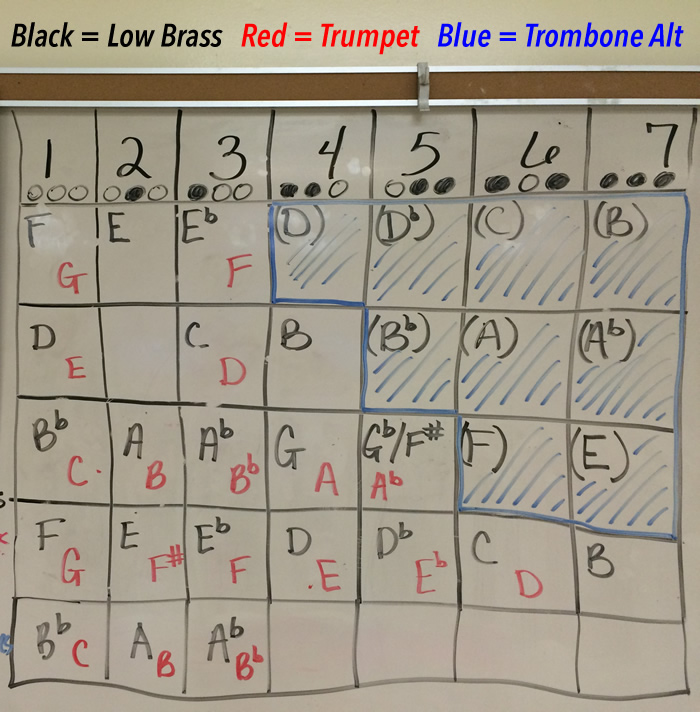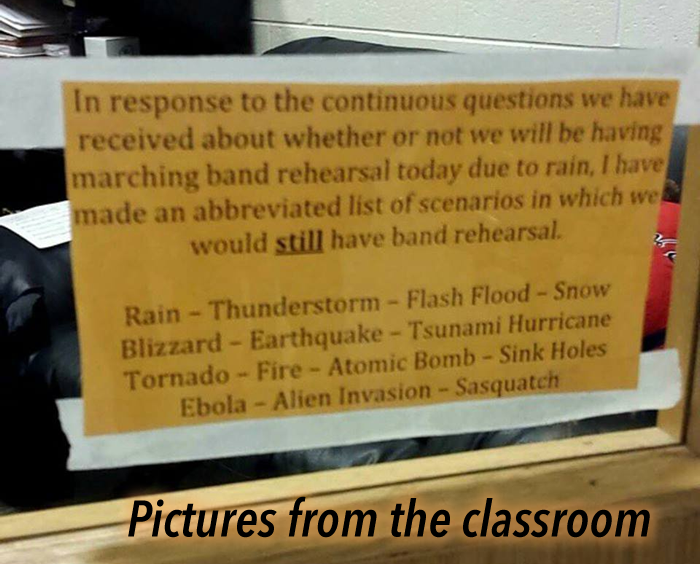Monday, November 2, 2015
IN THIS ISSUE:
Low Brass | Pics from the Classroom
Teaching Beginning Low Brass Students
by Bridgett Randolph
Starting young students off on low brass instruments is sometimes a very daunting task. Often they are in that awkward stage in growing up and now we are putting an instrument in their hands that is as big as they are. You need to expect coordination issues and plan for extra time in your setup to accommodate for that. They will be a little slower at first then their high brass counterparts.
 I find that it is a really good idea to use about 5-8 class periods before the students get their instruments to teach breathing, posture, and basic theory. (The staff, identifying notes, different types of notes, and we start with rhythm. (Half notes, quarter notes, and whole notes.) This is an excellent time to start teaching the air needed to play these rhythms as well as how to start the beginning of each note with the tongue. An excellent website to use for note identification is www.musictheory.net. This website will let you customize exercises into the clef sign that you want as well as let you take out accidentals and key signatures so that you can just concentrate on the lines and spaces of the staff. Don't forget to help the tuba players as well and make your range go down to their low Bb.
I find that it is a really good idea to use about 5-8 class periods before the students get their instruments to teach breathing, posture, and basic theory. (The staff, identifying notes, different types of notes, and we start with rhythm. (Half notes, quarter notes, and whole notes.) This is an excellent time to start teaching the air needed to play these rhythms as well as how to start the beginning of each note with the tongue. An excellent website to use for note identification is www.musictheory.net. This website will let you customize exercises into the clef sign that you want as well as let you take out accidentals and key signatures so that you can just concentrate on the lines and spaces of the staff. Don't forget to help the tuba players as well and make your range go down to their low Bb.
Once you get their instruments set up correctly, make sure that they are holding it correctly. It is very uncomfortable for trombone players at first. Just remember that you can adjust their setup by bringing the slide in closer to the bell so that their fingers can reach all the way to the mouthpiece when they are holding the trombone in their left hand. Watch the trombone players carefully as their left hand will often change to a fist to be more comfortable. They will get use to the correct hand position very quickly if you are adamant. Make sure that the tuba players are comfortable and that they have enough space around them. Many young tuba players will need a stand because they can not sit the tuba on the chair and then be able to reach the mouthpiece. There is not enough room on the chair. If a tuba stand is not available, you might consider turning a piano bench sideways and then having the student sit on a phone book. When teaching the right hand for the valve instruments, I have the students pretend that I am handing them a can of soda so that they get the "C". Then I have them pretend that they are pouring it into a glass and place their fingers on the valves. For trombone players, make sure they are holding the slide in their right hand with their thumb, first, and middle finger. When the students begin using a music stand, try to let each student have their own stand. This is important for low brass because of the size of the instruments that they are holding and to have good posture. Trombone stands should all be set up on the right side of the student and their slides should go beside the stand, not under it! A good trick is to put another chair sideways in front of the students who are having trouble with this. Their slide would need to go over the seat of the chair. Trombone players that have their music stand on the left side will end up dropping their instrument down because they cannot see through the bell of their instrument and their slide will be underneath the music stand.
Warm ups
I like to warm up with three different parts to the warm up. (It takes most of the class period in the beginning, but it will pay off in the long run!) The first part is buzzing...lip only buzzing, mouthpiece buzzing, and mouthpiece sirens. Make sure that the students are counting whole notes here and keeping the beat. It's a lot easier for them to get this habit ingrained when they are only dealing with the mouthpiece of the instrument. The second part is long tones and then as soon as they have a little strength lip slurs. Even at the very beginning...these are great fun and they don't need to know what note they are playing...they just need to match!) The third part of the warm up is positions. (Even for the baritones, tubas, and trumpets.) I teach fingerings to them like trombone positions. The trombone players need the practice of looking at their slides and feeling where each position is. I start out with 1, 2, 3, and 4. Positions 5 and 6 are included as soon as we learn C. I don't worry about 7 until later. The players say the positions while they are watching their slides or valves. We go slow at first and then we speed up. We also play it. Your students will understand the chromatic scale so well by the end of the year and the beauty is they won't even know it. Then when you teach it to them it will be very easy!
The final thing that I will leave you with is this. I think that the fingering and slide charts in the back of the technique books are a huge disservice to our brass students. They need to see a visual representation of partials. This helps them understand that THEY determine if their note is going to be a high or low one. A chart like this also helps with understanding enharmonics, half steps, and sharps and flats. (It also helps the trombone players understand alternate positions and it lets all of the brass see that as you go higher, you use less of your instrument.) A part of the "chalk board" in my class room was always dedicated to the brass bookshelf. As we learned new notes in the book, we would write them in on the correct shelf. (Most of the notes have already been played while doing the position warm ups, I just don't go into the note names then.)

 |
Bridgett Randolph Bridgett Randolph received her B.M.E. from Central Methodist University and her M.Ed. from William Woods University. She has taught instrumental music for the last 18 years with the latter 10 years in the Columbia Public Schools. Bridgett also taught high school and middle school at Orrick R-IX, Mid-Buchanan R-V, and Southern Boone R-I school districts. Bridgett is a member of MMEA, NAfME, MNEA, MBA, and Phi Beta Mu. Bridgett has performed with the Columbia Community Band, Columbia Civic Orchestra, Memories Dance Band, Capitol Kicks Dance Band, Ray Auburn Big Band, and Kerry Strayer Big Band. She is active as a clinician and adjudicator and enjoys playing in big bands and community ensembles so give her a call if you need a trombone player! Bridgett currently resides just outside of Columbia, MO with her husband Mark, and their two wonderful children Olivia and Logan. |

